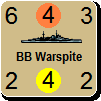warspite1
Posts: 41353
Joined: 2/2/2008
From: England
Status: offline

|
Following on from Post 165.
21st – 27th November 1939 (North Atlantic and North Sea – Surface fleet action)
The sortie by Scharnhorst and Gneisenau was ordered in order to assist the Graf Spee - still in the South Atlantic at this time but preparing for her voyage home. To this end, and as mentioned in Post 146, in addition to the battlecruisers, Donitz had been ordered to place some U-boats in the North Sea ready to intercept any Royal Navy vessels that sought to intercept Vice-Admiral Marschall’s ships should they be found. However the U-boats were to play no further part in this story.
The battlecruisers mission was not designed to be a breakout into the Atlantic; merely a feint in order to tie up Allied forces that could otherwise be deployed elsewhere. In addition, and subject to the usual rules not to engage more powerful enemy forces, Vice-Admiral Marschall’s ships would hopefully sink whatever targets presented themselves during the course of the operation.
Shortly after leaving port the escorting light cruisers and destroyers detached from the battlecruisers in order to conduct patrol work in the Skaggerak. Not for the first time, British reconnaissance (aided by poor weather conditions) was lacking, and Scharnhorst and her sister were completely undetected as they made their way toward the Faroes Gap between Iceland and the Faroes Islands.
Two days into the voyage, just before 1600hrs on the 23rd, the Scharnhorst’s lookouts spotted a ship about 15 miles away on their starboard bow. Gneisenau was over 10 miles further back at this point and Scharnhorst set course to intercept the ship alone while Marschall’s flagship steamed northwest to assist. Scharnhorst’s commander, Kapt. Kurt Hoffman, ordered that the unidentified vessel be signalled to ask “What ship?” and also to order radio silence.
Meanwhile, aboard the Armed Merchant Cruiser Captain Edward Kennedy’s options were limited to say the very least. With guns that could easily be outranged, a top speed nothing like enemy she was about to face, and no support close to hand, Kennedy must have known all too well how this would play out. Upon hearing of the outbreak of war, Admiral Erich Raeder wrote in his memoirs that the best the men of the Kriegsmarine could do was to “go down fighting” and to “show that we know how to die gallantly”. Swap HMS Rawalpindi for Kriegsmarine and I suspect Captain Kennedy was feeling exactly the same…..
The sender of the signal was erroneously identified as being a Deutschland-class panzerschiff by those aboard Rawalpindi, but that made no difference to the situation faced by the British ship. Kennedy ordered that the signal be simply acknowledged and, in line with orders turned away from the enemy whilst giving time to report the encounter to the Home Fleet. Having done so, nothing would be heard from HMS Rawalpindi again. Upon receipt of the communication, Admiral Forbes ordered the Home Fleet to sail.
At just after 1600hrs and with the range at 8,000 yards the battle began. Having seen that the enemy ship would not surrender, Hoffman ordered fire to commence and Scharnhorst’s very first salvo found the target. In so doing both the bridge and the radio room were destroyed. The second salvo was equally devastating, smashing into the engine room. The Rawalpindi fought back as best she could but with all power gone, shells had to be manually brought to the guns.
Soon Gneisenau too opened fire on the already burning and doomed vessel and, in less than fifteen minutes from the first shell landing, it was all over. Rawalpindi, ablaze from stem to stern, would soon disappear beneath the waves, taking 238 men with her. There were just 38 survivors – most of whom were rescued by the German ships.
Meanwhile Royal Navy ships close by that had picked up Rawalpindi’s radio message had headed straight for her reported position. The first to arrive was the light cruiser HMS Newcastle. The arrival of the cruiser ended any further rescue efforts and the German ships withdrew. It appears strange that Marschall did not seem to consider attacking the Newcastle. Both she and the approaching HMS Delhi would have been unlikely to survive an encounter with the two battlecruisers. The operations staff back in Berlin would later be asking the same question too….
The weather made Marschall’s escape easier as Newcastle, lacking radar, was unable to maintain contact in the gathering darkness and deteriorating conditions. Admiral Forbes ordered his ships into position to intercept the German vessels should they seek to return home or indeed to continue on to the Atlantic. To cover the latter the aircraft carrier Furious, the battleship Warspite and the battlecruiser Repulse were ordered to the Denmark Strait and the battlecruiser Hood and the French fast battleship Dunkerque were assigned to cover any breakout further east. Off the Norwegian Coast a line of cruisers – Southampton, Edinburgh and Aurora - was placed to intercept should Marschall head home. The cruisers were covered by the battleships Nelson and Rodney and the heavy cruiser Devonshire.
But to the intense frustration of all concerned, Marschall was able to evade the pursuers. After sailing into the Norwegian Sea, where the two battlecruisers spent two days waiting for the weather to worsen, they then managed to sneak through the patrol line and were able to return to Germany by the 27th. It was another disappointing episode for the Royal Navy. The loss of the carrier Courageous – and the patrol capability she would have given - was being felt already. To make matters worse, while returning to port, HMS Nelson struck a mine and was sidelined for months to come….
Back in Germany, there was mixed emotions amongst the staff officers of the OKM and the performance of Vice-Admiral Marschall - and specifically his perceived lack of aggression in response to the arrival of a 6-inch cruiser - was debated. Ultimately though, Raeder let the matter drop.
Having been previously identified as one of the ships destined for use as an Armed Merchant Cruiser in the event of war, SS Rawalpindi was requisitioned by the government in August 1939. Before being drafted into service as the AMC HMS Rawalpindi she was a 16,700 ton, 17-knot passenger liner, built in 1925, and operated by the P&O line between the UK and India. Reflecting her proposed use, she was named after a town in India (modern day Pakistan). In more peaceful times she could carry almost 600 passengers. As an AMC she was given eight 6-inch guns and two 3-inch anti-aircraft weapons. She was crewed by 286 officers and men (sixty of which were from her peacetime crew) and captained by Edward Kennedy RNVR, a 60-year old Royal Navy veteran brought out of retirement upon the outbreak of war.
The end of the valiant Rawalpindi.

Sources:
The War at Sea 1939-45 Volume I (Stephen Roskill)
The Gathering Storm (Geirr H Haarr)
www.naval-history.net
 Attachment (1) Attachment (1)
< Message edited by warspite1 -- 6/21/2015 7:55:03 AM >
_____________________________
England expects that every man will do his duty. Horatio Nelson October 1805  |
 Printable Version
Printable Version





























 New Messages
New Messages No New Messages
No New Messages Hot Topic w/ New Messages
Hot Topic w/ New Messages Hot Topic w/o New Messages
Hot Topic w/o New Messages Locked w/ New Messages
Locked w/ New Messages Locked w/o New Messages
Locked w/o New Messages Post New Thread
Post New Thread